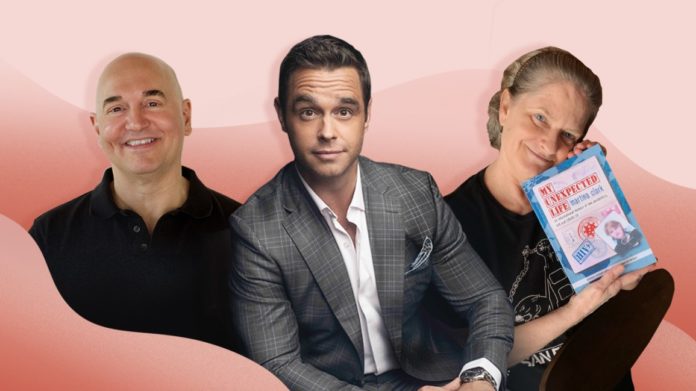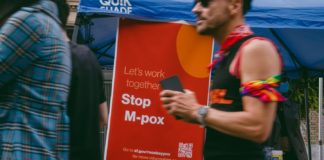
In 1985, in the early years of the HIV pandemic, gay rights activist Cleve Jones encouraged allies to write on placards the names of loved ones who’d died of AIDS. Taped together on the wall of the San Francisco Federal Building, the placards looked like patchwork.
The moment sparked the idea for the AIDS Memorial Quilt — an actual quilt, made with materials and sewing tools donated from people around the country to commemorate lives lost. The quilt was toured around the country for years, with new panels of names added in every city where it’s displayed.
Now part of the National AIDS Memorial in San Francisco, the 54-ton tapestry features roughly 50,000 panels honoring more than 105,000 people and continues to grow.
The AIDS Memorial Quilt is arguably the largest and best-known example of art and storytelling as a form of AIDS activism — but it’s far from the only one. Here are three people living with HIV who use their storytelling skills to promote awareness.

In 1985, John-Manuel Andriote was working on his master’s in journalism at Northwestern University’s Medill School of Journalism. That year, prominent actor Rock Hudson publicly disclosed his AIDS diagnosis and died of AIDS-related illness. Also that year, Andriote learned that two of his friends had died of AIDS.
“I was very aware, as a budding young journalist, of this huge issue that was slowly exploding,” he says. “And I had the sense that this was going to be one of the defining events of my lifetime.”
So Andriote decided to use his skills as a journalist to document and share stories of people affected by HIV and AIDS — a pursuit that would become a major focus of his reporting throughout his career.
After graduating, Andriote moved to Washington, D.C., where he began writing about the topic for various publications. At the same time, he became involved with a man, Bill Bailey, who was diagnosed with HIV shortly after they’d met.
“Then it was very personal,” he says, “as personal as literally as the person in the bed with me.”
Bailey was lobbying Congress to fund HIV prevention programs through the Centers for Disease Control and Prevention (CDC). “He said to me… ‘It’s your responsibility as someone with journalistic skills to tell our community’s stories,’” Andriote recalls. “He sort of reinforced what was already going on in my mind.”
Andriote wrote “Victory Deferred: How AIDS Changed Gay Life in America,” which was published in 1999. “There’s still no other book like it in the AIDS literature that looks at the epidemic from the inside of the community that was hardest hit by it,” he says.
He continued to write about HIV and broader health topics, with activism always at the forefront of his work. Then just after his 47th birthday, he found out he was HIV-positive.
“After 20 years of telling other people’s HIV stories, now the question for me was, ‘How am I going to tell my own story?’” he says.
Andriote had to decide how he was going to find his voice while also rising to what he calls the biggest challenge of his life. So he opted for a story of empowerment, which became “Stonewall Strong: Gay Men’s Heroic Fight for Resilience, Good Health, and a Strong Community,” published in 2017.
In the book, Andriote tells the stories of about 100 people, as well as his own. “What was fascinating in writing it was becoming aware of how exceptionally resilient most gay men are in spite of our multiple traumas,” he says.
Today, Andriote continues to report on HIV, AIDS, and issues related to gay men in a regular column called Stonewall Strong.
“I take lessons from my own experiences, from the experiences of other gay men, and kind of draw lessons from them that really anybody interested in resilience can apply to their own lives,” he explains.
Looking toward the future, Andriote hopes for continued progress on HIV research. But he also says there’s something we can all do at a basic level to help right now.
“I would love to see a time when medical diagnoses aren’t used to discriminate and judge other people,” he says, “that we recognize we’re all human and that we’re all vulnerable to things going wrong in our bodies. I hope there will be more support for one another, rather than using health and medical issues as yet another reason to divide ourselves.”
In 1992, at age 28, Martina Clark lived in San Francisco — the “epicenter“ of the HIV crisis, she says. “But not for women,” Clark adds.
She hadn’t been feeling well, and she’d been to see her doctor many times. “Eventually, he said, ‘I don’t know what else to do. Let’s do an HIV test,’” she recalls. “Women just weren’t visible in the pandemic.”
When she got the results, Clark says she felt like the only woman on the planet with HIV. At a loss of what else to do, she threw herself into activism. In 1996, she eventually became the first openly HIV-positive person to work at UNAIDS. It gave her a sense of purpose.
She continued working as an activist around the world, serving as the HIV advisor for the Department of Peace Operations at the UN headquarters and as the HIV in the workplace coordinator for UNICEF. But her heart pushed her toward writing.
So, at age 50, Clark enrolled in an MFA program in creative writing and literature at Stony Brook University. Her thesis morphed into what is now her recently published book, “My Unexpected Life: An International Memoir of Two Pandemics, HIV and COVID-19,” which explores the parallels between the HIV/AIDS epidemic and the COVID-19 pandemic from a personal perspective.
“I’m a virus overachiever,” she says, noting that she contracted COVID-19 in March 2020.
Clark continues to use writing to raise awareness about HIV and AIDS — and teaches others how to use the craft for their own activism, as well. Her goal is to include women in the HIV narrative, since she says they’ve largely been left out.
Clark expresses frustration about the lack of knowledge in the medical community about women aging with HIV. “How can you just sort of shrug your shoulders and not know?” she says. “That’s not an acceptable answer.”
Aging with HIV is something Clark is still surprised about — when she received the HIV-positive diagnosis, she was told she’d have just 5 years to live. It has become a topic she continues to explore in her writing today.
As the host and executive producer of +Life, a media organization fighting to end HIV stigma, Karl Schmid is an outspoken activist working to advance the national dialogue about HIV. But going public with his own HIV journey took some time — about 10 years.
Working in television production and artist management in London in 2007, he held off on a public disclosure of his diagnosis because people advised him to keep quiet. He also feared that sharing it would harm his career as a correspondent for KABC in Los Angeles or he’d become known as “the guy on TV with AIDS,” he says.
“The weird thing is,” he adds, “I am now known as the guy on TV with HIV, and I couldn’t be prouder.”
The turning point came about 3 1/2 years ago, Schmid posted openly about his diagnosis on social media. It marked the beginning of his journey as an activist storyteller.
Not long after that post, Schmid and a colleague explored the idea of creating a platform to connect people living with HIV from around the world. And that’s how +Life was born.
From there grew +Talk, a weekly show during which Schmid chats with people who are either living with HIV or working on stopping HIV. The goal is to provide science-backed information and a sense of community in a conversational and down-to-earth way, while combatting the stigmas against people living with HIV.
“We’re fed these lines that if you’re HIV positive, you’re a sinner, you’re dirty, and there’s something wrong with you. If you hear that enough, you believe it,” he says, adding that he wants to make sure viewers know that couldn’t be further from the truth.
The show aims to spread the message that
“I only learned that 3 years ago,” Schmid says. “It was like someone gave me the keys to the handcuffs that had been slapped on me when I was 27. And suddenly I was allowed to love again. I was suddenly allowed to value myself again and believe that other people could love me and value me without HIV getting in the way.”
Schmid says he got fed up with “standing in the shadows,” and he hopes his activism can be a catalyst for change.
“Now I stand in the sunshine, and I get to live my life,” he says. “If you still look at me and go, ‘Ooh, but you’re dirty or you’re damaged,’ I now look at that person and say, ‘I’m not, sweetheart.’ And I try to teach somebody and hopefully that person then takes that lesson and shares it with somebody else. It’s all about starting a conversation and keeping the conversation going.”








